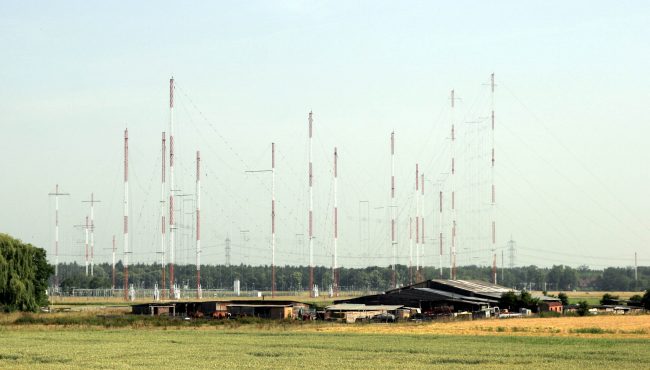There are four of these stations in Canada. In my scanning of the shortwave frequencies, I have found CFRX on 6070 KHz to put a strong signal into my location pretty much 24/7. At night it is drowned out by interference but daytime is listenable from local sunrise until about an hour before local sunset with a 100 uv signal. A look at the map reveals the CFRX transmitter site is roughly 300 miles away. CFRX is a relay of CFRB, 1010 KHz in Toronto, Ontario, Canada. CFRB does not come in here at all due to protecting 1010 WINS in NYC.

What I find very interesting is the station uses 1 KW TPO into a single 50-foot (117-degree) vertical tower. That is a pretty low-tech transmission facility, nothing like the minimum 50 KW with a 10 dB antenna requirement the FCC stipulates for shortwave broadcasters in this country. Even so, it generates a big useable signal, in the case of CFRX, covering nearly 300,000 square miles very inexpensively.
CFRX has been relaying CFRB’s signal since 1937. According to the ODXA site, the station uses a Bauer 701B modified to transmit on HF. The Bauer transmitters were always solid units. It went off the air in 2008 for several months while the transmitter was repaired, but eventually, it did return. Obviously, the station ownership finds value in the service and it continues today.
I often wonder why the FCC won’t allow a similar HF relay service here in the US. Daytime propagation on the tropical bands (75 and 60 Meters (3.9-4 MHz and 4.7 – 5.06 MHz respectively)) would allow low-power relays to cover large areas like CFRX. Tropical band propagation is such that nighttime coverage may be degraded by interference from other, more powerful stations offshore. Even so, it seems like a good way to cover a lot of ground in an economical way.
Other Canadian shortwave relay stations:
| HF Call sign | Power/frequency | Parent station | Location | Power/frequency |
| CFRX | 1000/6060 | CFRB | Toronto, ON | 50 KW/1010 |
| CFVP | 1000/6030 | CKMX | Calgary, AB | 50 KW/1060 |
| CKZN | 300/6160 | CFGB (CBC R-1) | St. Johns, NF | 4.5 KW/89.5 MHz |
| CKZU | 500/6160 | CBU (CBC R-1) | Vancouver, BC | 50 KW/690 |
Power in watts, frequency is KHz unless otherwise noted.
I know the CRTC would like to do away with these stations, but I think that is foolish.






A good question? They allow just about anything else! OPP (Office of Plans & Policy) is all lawyers that follow the money. If the cash register rings or has a slight chance of ringing (even momentarily), they are all for it. And the NAB is all tied up with much the same people looking down the same narrow tunnel. Maybe, when the TV and Radio broadcasting industry really goes into the doldrums, some politician may bring back the innovating Engineers, but my guess is not anytime soon.
There a few SW relays down here in Aus that cover the areas MW forgot:
http://www.abc.net.au/reception/radio/shortwave.htm
Its amaizing how well they work when your out in the middle of no where.
There is no warning of pending band switch from day to night frequency.
ABC runs a good operation. I was listening in on the Queensland flood coverage on 6020 Khz, they did a fantastic job, good spot coverage, breaking news, advisories, etc. I like their AM antenna page:
http://www.abc.net.au/reception/radio/am_antenna.htm
I noticed they don’t play a sign off or on announce, just a few verses of Waltzing with Matilda.
Interesting post Paul: BTW I have that very same QSL card!
Some years ago 1010 kHz WINS and CFRB reached an agreement whereby each station would send a little more signal towards each other and each agreed to tolerate a little more interference. You can hear the CFRB signal under the WINS carrier during pauses in the programming when there is no modulation.
I think 6020khz would have been radio australia. They sometimes relay local ABC radio on radio australia too. I just came back from holiday in QLD and was glad to get out of there. They were warning of a possible closure of an 855khz transmitter and asking people to switch over to an FM station. I was wondering if they would remove the transmitter or try and clean up after the fact. I don’t think it happened. Having smelt and seen the smoke of black saturday I can vouch the ABC’s work and how all normal programming gets swept aside when needed.
This goes back a few years but an interesting read:
http://www.broadcastaustralia.com.au/media-room/newsletter-stories/march-2009/black-saturday-at-mt-tassie
http://www.abc.net.au/local/photos/2009/04/14/2542257.htm
The above site:
http://web.acma.gov.au/pls/radcom/site_search.site_lookup?pSITE_ID=12044